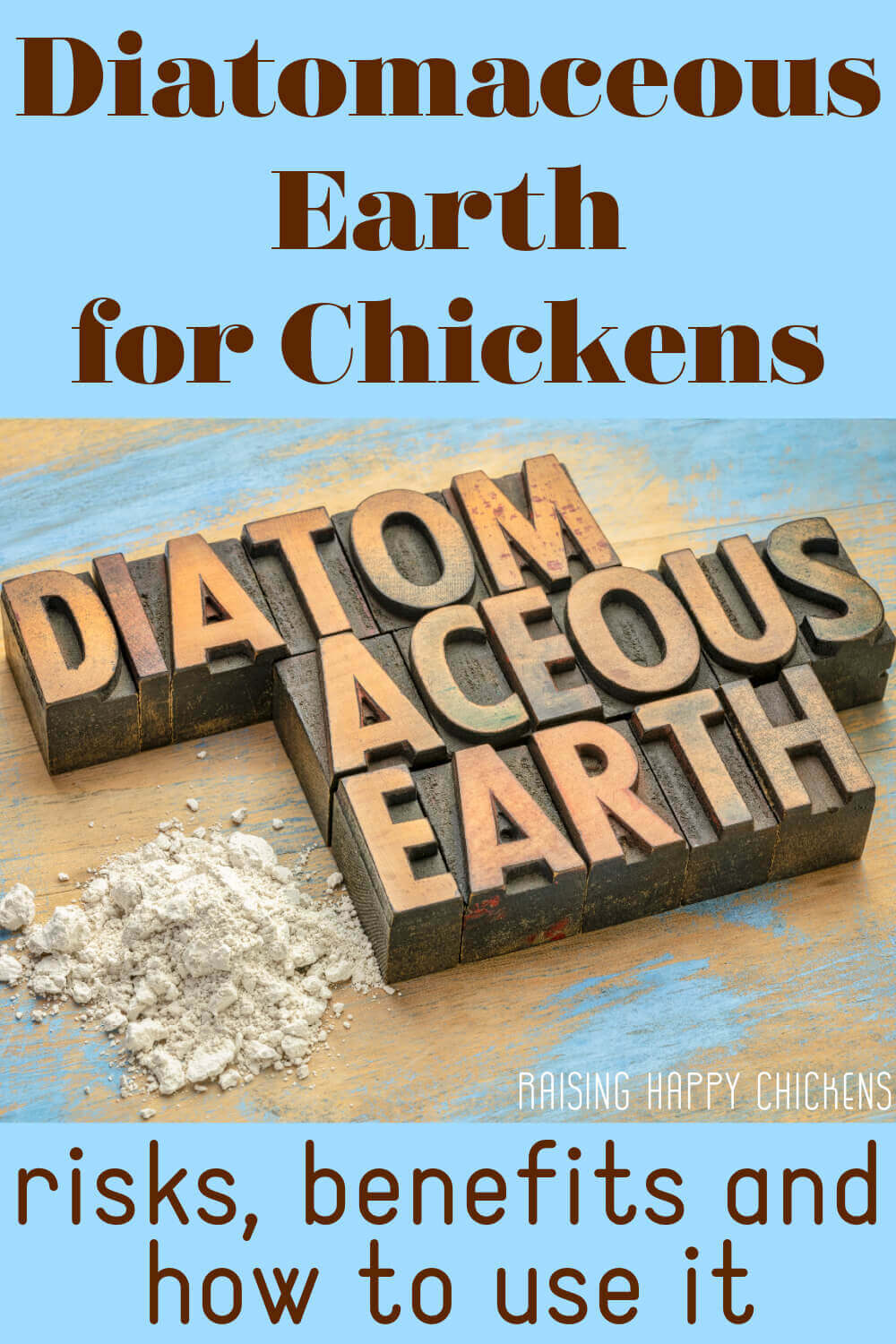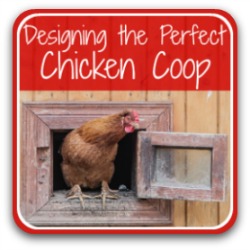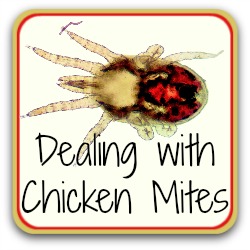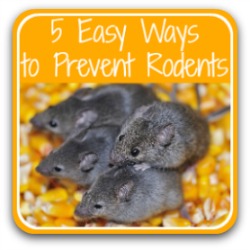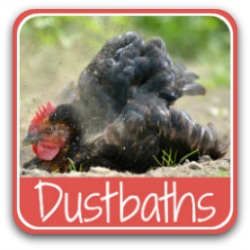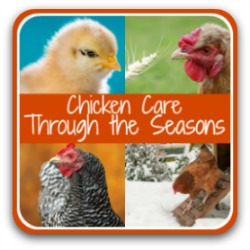Diatomaceous earth for chickens: safe to use, or a health hazard?
Using diatomaceous earth in the chicken coop can help eradicate infestations of troublesome parasitic pests like red mite and lice.
But its use is highly controversial. Many backyard chicken keepers consider it a miracle cure and use it liberally in the coop and run.
For others its potential to harm a flock's health means it's a liability to be avoided. Others still use it within what they consider to be safe limits.
Which will you choose as the best option for your chickens?
I'm not going to presume to tell you what to do.
As with many things in life, you must examine the facts and make a decision for yourself about what's best in your own situation.
That decision will not be the same for everyone. It will depend on your circumstances and your point of view.
My aim here is simply to present the facts as I know them, with proper sources as my foundation, and to tell you what I do, and why.
The rest is up to you.
This is a long, detailed article. Use the links below to find the information you want most, or read through the whole article so you don't miss any vital information.
What is diatomaceous earth (DE)?
In terms of knowing whether it's a safe, natural substance, it helps to know how diatomaceous earth is formed.
It's made from the fossils of microscopic aquatic algae called diatoms. Over many thousands of years, diatoms collected in rivers and streams. Their skeletons are made from silica, and it's that which is mined from those areas today.
The mined substance is then ground into a fine powder.
What is in diatomaceous earth powder?
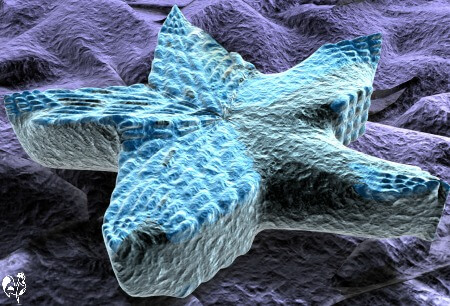 A computer rendering of a diatom under the microscope.
A computer rendering of a diatom under the microscope.The fossilised diatoms are made of almost pure amorphous silicon.
This is important, because it's the crystalline form of silica which can cause silicosis - a form of lung cancer(1).
So it's important when buying it to make sure the crystalline component is as low as possible.
In the US, a product is considered safe if it is less than 2% crystalline silica, but that's considered high in other countries.
What should not be in diatomaceous earth is any form of additive, including antibiotic powder, or "filler", which is used in poorer quality DE to bulk it out.
What does "food grade" diatomaceous earth mean?
- The difference between diatomaceous earth and food grade diatomaceous earth is the level of filtration it goes through.
- Regular DE is also known as filter, pool or garden grade, and is used in industrial processes (including making dynamite!). It is toxic and therefore not safe for consumption either by humans or by animals. Or chickens.(2, 5)
- Always look for food grade diatomaceous earth.
How does diatomaceous earth work?
So exactly what does diatomaceous earth do?
Here's a simple scientific explanation for how diatomaceous earth works for external parasites like red mite and lice:
"Diatomaceous earth causes insects to dry out and die by absorbing the oils and fats from the cuticle of the insect's exoskeleton. Its sharp edges are abrasive, speeding up the process. It remains effective as long as it is kept dry and undisturbed"(2).
Links on the rest of this page are "affiliate links". If you click on them and buy, I earn a small commission at no cost to you. I only recommend products I know and love and which I think will be genuinely useful to you. See my disclosure policy for more information.
Diatomaceous earth: where to buy it and what should you look for?
Food grade diatomaceous earth is generally available from food and feed stores, or online. Wherever you buy from, for use with your chickens make sure it...
- is food grade only
- contains less than 2% crystalline silica (and if possible, lower than that)
- has no fillers (some contain chalk or sand)
- is mined as locally as possible
- comes packed in a strong, airtight bag - the last thing you want when you open a package is the dust flying everywhere.
The Harris brand of diatomaceous earth is recognised as a high quality food grade product, and contains less than 1% crystalline silica. (It doesn't say that anywhere on the product, so I wrote to the manufacturer who confirmed).
It also has a free powder duster, which we'll see the benefit of later in this article.
Does diatomaceous earth expire?
No – it will keep indefinitely providing it's stored properly. If it becomes damp it will degrade and will be ineffective in terms of controlling infestations.
Store it in a cool, dry place, preferably in a sealed container.
Is diatomaceous earth safe? The risks and side effects.
- As long as the amorphous content of DE is high and the crystalline content low, it is considered safe. The main concern has been about the risks of breathing in the dust.
- One study demonstrated that mice forced to breathe diatomaceous earth for one hour each day for a year had an increased incidence of lung cancers(2). So it seems that prolonged, consistent exposure can cause harm.
- As chicken keepers, we would not have that level of exposure, and if it's given correctly, neither would our chickens. But there's no doubt that DE is a very fine, dusty powder which, unless it's handled carefully, can fly everywhere.
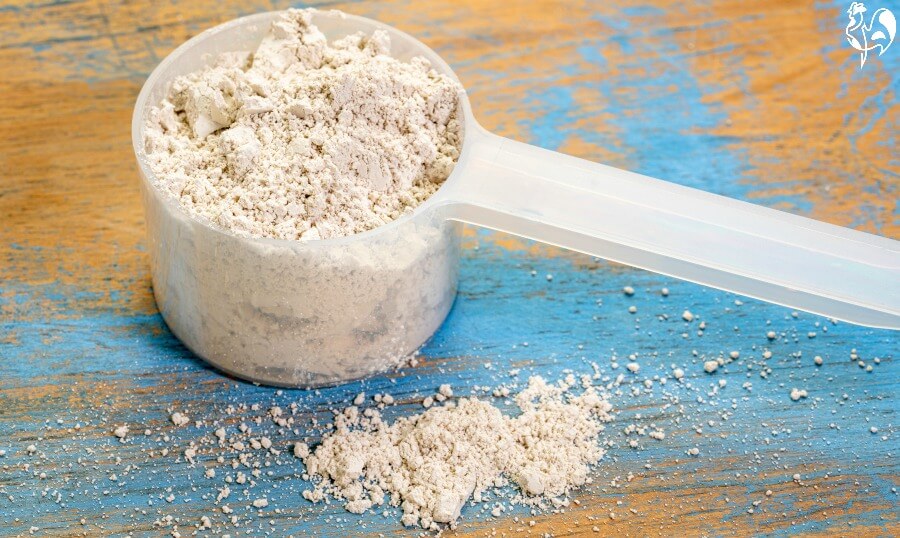 Diatomaceous earth is a fine powder – don't breathe it in.
Diatomaceous earth is a fine powder – don't breathe it in.- Gail Damerow, in "The Chicken Health Handbook", suggests that particles of diatomaceous earth can stick to chickens' lungs and create respiratory problems. However, it's known that it is crystalline silica, not amorphous, which causes respiratory issues.
- Nevertheless, we need to make sure it's applied and used in such a way as to prevent chickens breathing it in – see below for tips as to how.
- For us as chicken keepers to be completely safe, I would suggest wearing a mask or some other form of nose and mouth covering when using it.
- You don't need a surgical mask. Something like this does very well. Even a scarf tied tightly round your nose and mouth is better than no cover at all.
More questions about diatomaceous earth and safety.
Is diatomaceous earth safe for pets like dogs and cats?
Is diatomaceous earth safe for pets like dogs and cats?
Yes, as long as it is food grade it's safe for humans and animals. However, it's known to cause respiratory problems if it is breathed in, so do not use it by sprinkling it on or near your pets.
Is it safe to use diatomaceous earth in the garden?
Is it safe to use diatomaceous earth in the garden?
Again, if it's food grade it won't cause a problem, so for example forking in dust bath materials which include diatomaceous earth to the soil after use is acceptable.
Its uses for the garden are outwith the remit of this article. However, see below for its potential side effects on honey bees.
Does diatomaceous earth kill bees?
Does diatomaceous earth kill bees?
This is an important question for us if we want to preserve the bee population (as we should).
It can affect bees, if not used with care. However, the bee is less vulnerable than other insects. It has the advantage of being a flying insect so does not walk through DE powder, and its hairs protect its skeleton from absorbing it.
So to protect the bee, avoid applying DE near blossom, and don't use it anywhere you know bees are active.
Diatomaceous earth: benefits for chickens – the evidence.
There are many claims made for diatomaceous earth related to humans. This article is concerned only with its uses for chickens.
1. Diatomaceous earth uses: controlling parasites externally.
There are numerous studies (e.g. 2, 3, 4) which have demonstrated that diatomaceous earth controls parasites like red mite, northern fowl mite, fleas and lice.
2. Uses of diatomaceous earth for controlling internal parasites.
The scientific evidence for controlling internal parasites, that is parasites like worms inside the chicken's body, is much less clear – in fact, I've been able to find no conclusive evidence that it's effective for this.
It's also important to remember that unhatched worm larvae in the gut won't be affected by DE. For that reason I personally don't use it as a wormer.
3. Physical benefits of chickens eating diatomaceous earth.
Studies have shown that free range chickens who had DE added to their food were heavier and laid more and larger eggs containing more yolk and albumen(2).
So feeding diatomaceous earth to chickens in the right amount may be beneficial to their egg production.
Diatomaceous earth uses with chickens.
Dust bathing.
Because it's known that diatomaceous earth can help control parasites, it can be added to dust baths.
Dust baths help prevent parasites but they won't deal with an existing infestation quickly enough - for that you'll need to dust the DE directly onto the bird.
I'm lucky enough to have a large run, with several different areas the chickens use for their dust baths. They generally prefer to take their dustbath spas in loose earth, and I don't add any DE to those areas - the soil and grit present naturally is enough to keep parasites away.
I also provide an alternative of a child's sandpit turned into a dustbath in the shade of the fig tree in their run.
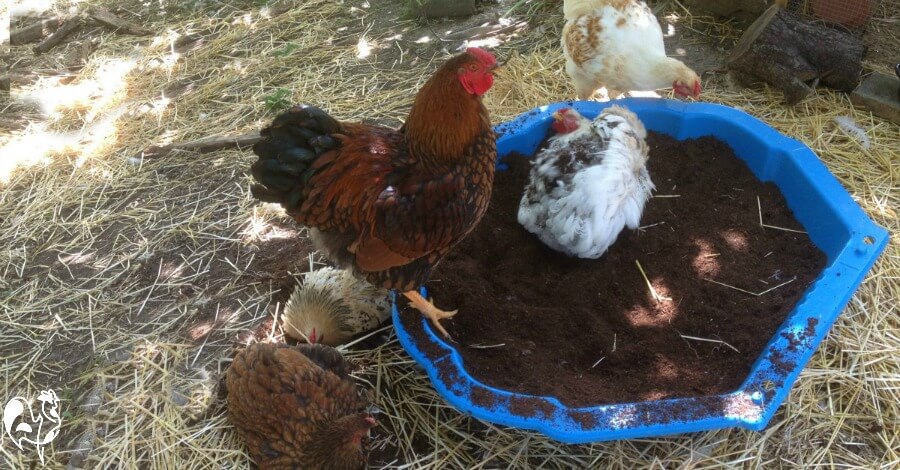 Some of my flock enjoying a spa day in a dust bath made from a child's sandpit.
Some of my flock enjoying a spa day in a dust bath made from a child's sandpit.Because the earth is contained, I do add diatomaceous earth to this dust bath.
It's mainly filled with potting compost, which they love, and some ordinary loose soil from the garden. To that, I add diatomaceous earth to make up no more than one quarter of the total.
Mix the DE in well. Having it as only a small part of a dust bath means there's not enough of it for the chickens to breathe in.
Don't leave this out in the rain - we saw earlier that DE is effective only when it's dry. When it gets wet it turns into a sloppy mess.
How to use diatomaceous earth in chicken feed.
If you want to experiment with DE in your chickens' feed, the recommendation is to sprinkle it on and then mix it in at the rate of no more than 5% of the total(3). I find it hard to estimate in percentages, so I'd use a quarter cupful to every 5 cups of feed.
But remember: there is no evidence that DE is an effective worm treatment.
Dusting: how to apply diatomaceous earth to a chicken.
If your chicken has a particularly bad infestation of parasites like mites, a dust bath won't be enough. You'll first need to get rid of the mites which are already there.
Parasites tend to gather around the chicken's vent and at the shaft – the bottom of feathers where they meet the skin.
Apply the diatomaceous earth there, and wherever else you see mites or lice crawling. Using an applicator like the one that comes with this Harris brand is helpful.
Bear in mind that it's better for both you and your chickens not to breathe it in, so...
- Don't dust chickens while you're in an enclosed area such as inside the coop – go outside.
- Apply it on a day when there's no breeze, so you can control where it's applied without it flying off anywhere else.
- I tend to cover the chicken's head loosely with a towel, while holding her under my arm. It makes her feel safer and at the same time ensures she's very unlikely to breathe in any dust.
Uses for diatomaceous earth in the chicken coop.
- Dust areas where you know mites and lice are likely to collect, such as the underneath of roosting bars.
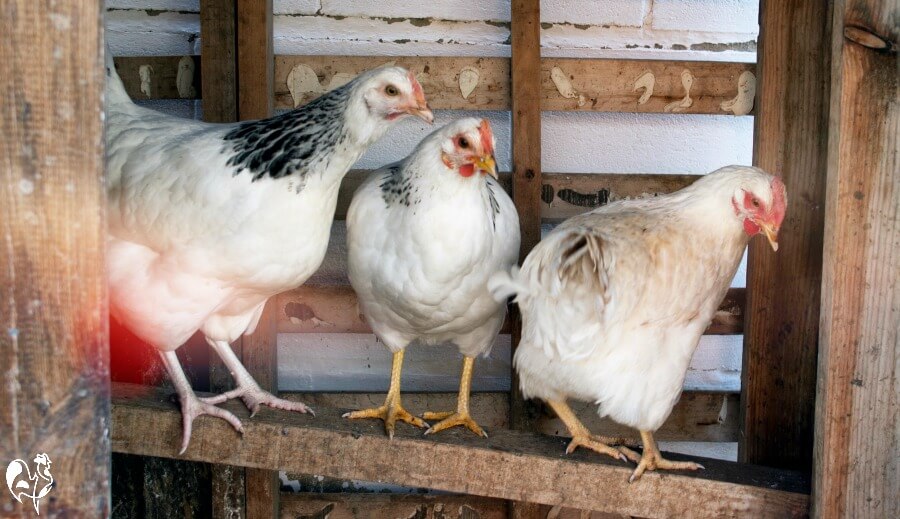 I check my roosts every week and dust the undersides with DE - that's where mites tend to gather.
I check my roosts every week and dust the undersides with DE - that's where mites tend to gather.- Make sure you do it when your chickens are outside the coop, and use a mask to cover your face.
- Some people use it in nesting boxes. I don't, unless I have a specific problem with an infestation and I'm waiting for the DE to work. It can take a couple of days to be effective on parasites, as it works by dehydrating them.
Conclusion: should you use diatomaceous earth?
As I said at the start, this is a personal decision we should all make for our own situation.
Diatomaceous earth can cause sometimes quite heated discussions between chicken keepers, and we must all take the available information and make a balanced judgement based on our own circumstances.
Personally, I don't use a lot of it, but I do use it in my container dust bath, to dust chickens down if they have obvious signs of parasites, and to dust those parts of the coop where I know mites collect.
So, take the information here and make your decision. Whatever it is, you can rest assured that it will be made based on proven studies and the best available information.
More about keeping chickens healthy, naturally.
Sources.
A lot of "facts" on the internet are often people's individual views, based on inaccurate information repeated from poor quality sources.
The information I provide in this article and others is based not just on my own experience, but on evidenced facts from scientific, peer-reviewed research and from highly respected and experienced poultry keepers such as Gail Dammerow.
Some of the sources I have used for this article are these. I’ve provided direct links for your convenience, unless the article is on a "not secure" page.
1. Occupational Safety and Health Administration: Crystalline Silica Exposure – Health Hazard Information. Pub. 2002.
2. Bunch, T. R.; Bond, C.; Buhl, K.; Stone, D.: Diatomaceous Earth. Pub. National Pesticide Information Center, Oregon State University, 2013.
3. Bennet, D., et al: Effect of diatomaceous earth on parasite load, egg production and egg quality of free-range organic laying hens. Pub. Journal of Poultry Science, 2011.
4. Maurer, V. and Perler, E.: Silicas for control of the poultry red mite. Paper published to the Joint Organic Congress, 2006.
5. Leech, J: What are the benefits of diatomaceous earth? Pub. Healthline, 2023.
